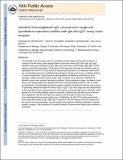Zebrafish immunoglobulin IgD: Unusual exon usage and quantitative expression profiles with IgM and IgZ/T heavy chain isotypes
Author(s)
Zimmerman, Anastasia M.; Moustafa, Farah M.; Romanowski, Kryzstof E.; Steiner, Lisa A.
DownloadSteiner_Zebrafish immunoglobulin.pdf (887.4Kb)
PUBLISHER_CC
Publisher with Creative Commons License
Creative Commons Attribution
Terms of use
Metadata
Show full item recordAbstract
The zebrafish is an emerging model for comparative immunology and biomedical research. In contrast to the five heavy chain isotype system of mice and human (IgD, IgM, IgA, IgG, IgE), zebrafish harbor gene segments for IgD, IgM, and novel heavy chain isotype called IgZ/T which appears restricted to bony fishes. The purpose of this study was to design and validate a suite of quantitative real time RT-PCR protocols to measure IgH expression in a vertebrate model which has considerable promise for modeling both pathogenic infection and chronic conditions leading to immune dysfunction. Specific primers were designed and following verification of their specificty, relative expression levels of IgD, IgM, and IgZ/T were measured in triplicate for zebrafish raised under standard laboratory conditions. During embryonic stages, low levels of each heavy chain isotype (IgH) were detected with each increasing steadily between 2 and 17 weeks post fertilization. Overall IgM > IgZ > IgD throughout zebrafish development with the copy number of IgM being several fold higher than that of IgD or IgZ/T. IgD exon usage was also characterized, as its extremely long size and presence of a stop codon in the second IgD exon in zebrafish, raised questions as to how this antibody might be expressed. Zebrafish IgD was found to be a chimeric immunoglobulin, with the third IgD exon spliced to the first IgM constant exon thereby circumventing the first and second IgD exons. Collectively, the qRT-PCR results represent the first comparative profile of IgD, IgM, IgZ/T expression over the lifespan of any fish species and the primers and assay parameters reported should prove useful in enabling researchers to rapidly quantify changes in IgH expression in zebrafish models of disease where altered IgH expression is manifested.
Date issued
2011-08Department
Massachusetts Institute of Technology. Department of BiologyJournal
Molecular Immunology
Publisher
Elsevier
Citation
Zimmerman, Anastasia M., Farah M. Moustafa, Kryzstof E. Romanowski, and Lisa A. Steiner. “Zebrafish Immunoglobulin IgD: Unusual Exon Usage and Quantitative Expression Profiles with IgM and IgZ/T Heavy Chain Isotypes.” Molecular Immunology 48, no. 15–16 (September 2011): 2220–2223.
Version: Author's final manuscript
ISSN
01615890